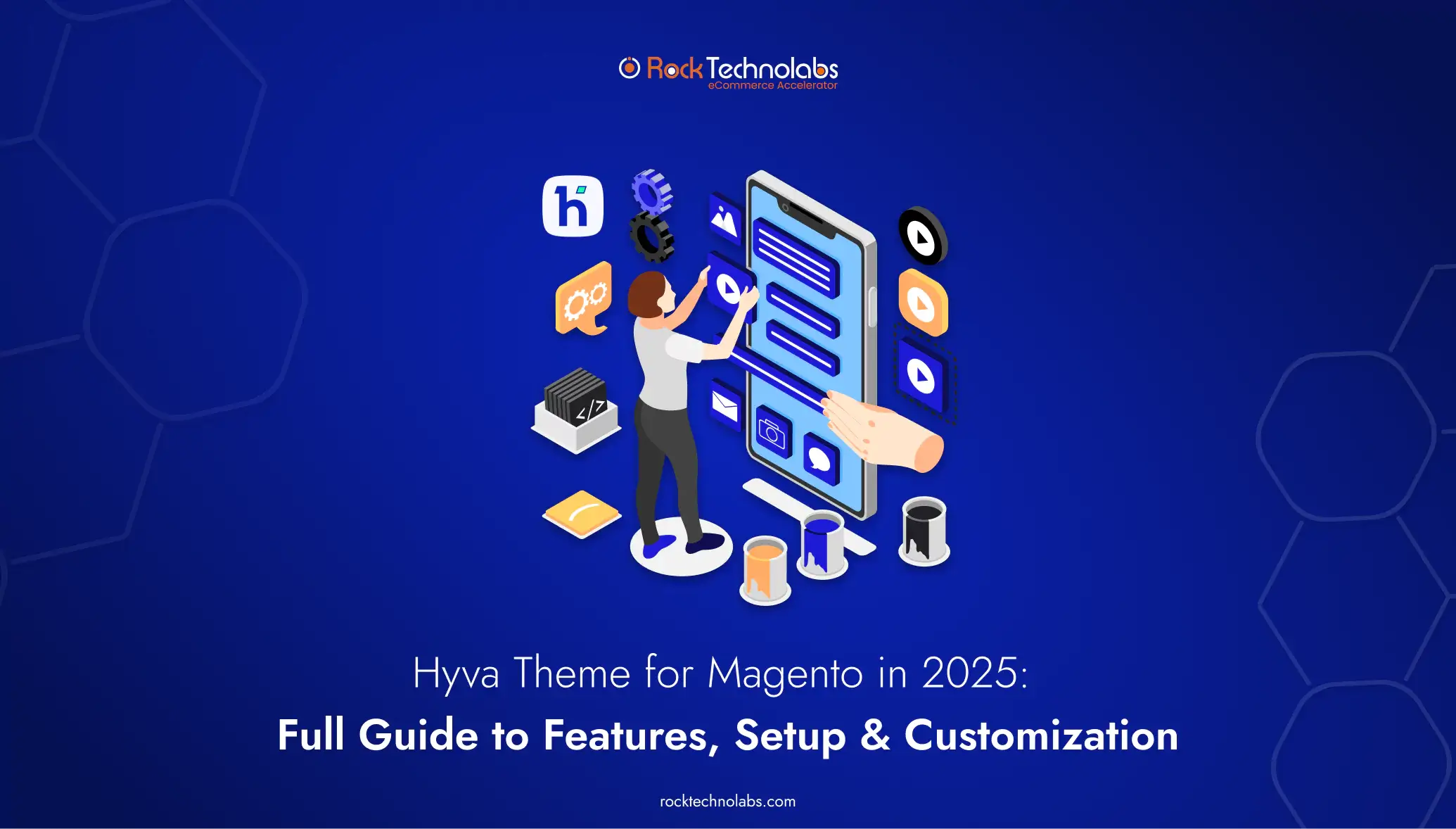Hyva Theme for Magento in 2025: Full Guide to Features, Setup & Customisation

Hyva theme Magento 2 was launched in 2025, however we can’t say it is is the technology that was launched 3 years back, because Hyva theme is coming up with new features, accompanied by extensions, and other compatible modules that was Hyva partner agencies which is needed in the ever-evolving world of eCommerce 2025.
However, even when the Hyva team is doing their best for Magento 2 stores, many merchants and developers are still unaware of its importance, which marks a bold new era for Magento users—and leading the charge is the Hyva Theme, a game-changer redefining performance, simplicity, and design with its comprehensive package that includes Hyva commerce, Hyva theme, Hyva checkout, and Hyva technology.
Moreover, in this comprehensive blog, our main focus will be on the primary features of the Hyva theme, how your Hyva theme Magento 2 store can be optimised with proper customisation, and how you can set up hassle-free to help you build a storefront that’s not only beautiful but built to convert. Ready to future-proof your Magento store? Let’s dive in.
Top Features of the Hyva Theme for Magento 2
1. Clean and Maintainable Codebase
In every ecommerce website, code should be easily understandable, modify, and maintain which means readable by others, accompanied by relevant documentation, and consistent in style and naming conventions, and this all is possible with Hyva because it is built on a clean and well-structured code architecture, making it easy for developers to maintain the theme even while working on other parts of store.
2. High Performance and Speed Optimisation
Due to the Hyva theme in Magento 2, efficient code optimisation abilities, it assists in dramatically reducing page load time and server resource usage, plus the lightweight code contributes to faster browsing, lower bandwidth consumption, and smoother user experiences. This type of optimised performance in your store offers benefits like better user experience, higher visibility on SERP, and more traffic for the store, which ultimately results in more conversions.
3. User-Friendly Design Elements
As an online merchant you don’t want to neglect design principles and elements for your Hyva theme Magento 2 stores because it ultimately impacts how users view your site. As Hyva themes are carefully crafted, it possess a modern, intuitive design that enhances the customer journey on Magento-based e-commerce sites by displaying a visually appealing interface.
4. Extensive Customisation Options
Hyva comes with excellent customization abilities so you don’t need to worry to tailor your store for your business and branding needs as it has various customizable layout options, color theme, typography settling, adding more levels to menu, product gallery options, image options, and so on, which means you can tailor nearly every aspect of the theme — from layouts and color schemes to typography and component behavior — to align with their unique branding and business goals.
5. Seamless Integration Support
You can easily integrate various Magento extensions and other third-party tools with the Hyva theme in regards to layered navigation, custom forms, free gifts, product labels, page speed optimisation, improved sorting, cookie consent, advanced reporting, and so on.
Read More: Hyva theme Updated Features
How to Integrate the Hyva Theme into a Magento Store
Step 1: Prepare Your Environment
Before starting anything in regards to the installation process, you have to make sure that the following prerequisites are in place, also don’t forget to take the backup of your Magento store:
- A properly installed Magento 2 instance
- Composer is installed on your system (Magento uses Composer for dependency and package management)
- Access to the file system, preferably via SSH
A clean, well-prepared development environment is essential for a successful integration.
Step 2: Purchase and Download the Hyva Theme
You have to visit the official website of Hyva to purchase the license for it, as it is considered a premium theme, or you can directly go to any verified partner marketplace. In addition to this, when the license is purchased, you will also get receive a downloadable package, typically in ZIP format, containing the theme files and documentation.
Store these files in a secure location for reference and installation.
Step 3: Configure the Repository
Once you have SSH access to your server, navigate to the root directory of your Magento installation.
Next, configure the Hyva repository using Composer. This allows your Magento installation to retrieve the necessary packages:
composer config repositories.hyva-theme vcs [Repository URL]
Replace [Repository URL] with the actual URL provided upon your Hyva theme purchase.
Step 4: Require the Theme Using Composer
Install the Hyva theme and its dependencies by running the following command:
composer require hyva-themes/magento2-hyva-theme
The composer will download and install all necessary components for the theme.
Step 5: Enable the Theme
Now comes activating the theme so you can prepare your Magento store for its new front end.
Execute the following commands in sequence:
bin/magento setup:upgrade
bin/magento setup:di:compile
bin/magento setup:static-content:deploy
Then, go to the Magento Admin Panel:
- Navigate to Content > Design > Configuration
- Select your store view
- Set the Hyva theme as the default
At this point, the Hyva theme becomes the new face of your storefront.
Step 6: Configure and Customise the Theme
Hyva is built with flexibility in mind. You can configure and customize it to match your brand’s identity either through the Admin Panel or directly via theme files.
- Design configurations can be adjusted via Content > Design in the Admin.
- For advanced changes, edit or extend the theme files in:
app/design/frontend/Hyva/[your-theme-name]
Custom CSS and JavaScript can be added here as needed.
Step 7: Test the Implementation
Once the theme is applied:
- Clear the cache using:
bin/magento cache:clean
- Visit the frontend of your site to confirm that the theme is rendering properly
- It also requires testing all the functionality properly, including navigation, buttons, sections, product pages, cart, and checkout, so there won’t be any issues later on.
Step 8: Launch
Next, in case the theme goes with your visual and performance goals, you can now consider the site ready for launch.
Step 9: Post-Installation Maintenance
After deployment:
- Regularly monitor site performance and user behaviour
- Stay up to date with Hyva and Magento releases.
- Apply updates and patches as needed to ensure security and continued compatibility
Read More: Hyva theme Integration
Tips for Customizing the Hyva Theme in Magento 2
1. Work with Layout XML and Templates
Layout basically are XML files in Magento 2 that enables developers to create various UI components that can be simple, minimalistic or complex ones, thus for a proper and appealing customization of product pages it plays a significant role with Hyva theme because they give you full control over whether you’re repositioning content blocks or restructuring entire layouts. Besides this, for advanced layout changes, it’s advisable to create a child theme instead of modifying core files directly. This ensures easier updates and better maintainability.
2. Optimise Assets for Performance
The biggest advantage that the Hyva theme offers is its speed and performance, and to maximise it to its fullest, it is necessary that you do proper asset management of your Hyva theme Magento 2 store. For instance, removing unused CSS classes, and minifying CSS (reduce bandwidth consumption) & Javascript (ensure better performance across all devices), optimising images without reducing their quality using formats like WebP, and implementing lazy loading for initial page load.
3. Customise UI Components
Hyva theme implemented in Magento 2 stores can be customized for text field, checkboxes, list, sliders, tags, icons, menus, breadcrumb, search options, image carousels, progress bars, modal windows, and other different buttons, headed, and forms upto an extend that it matched with the desired look, and feel a truly unique and intuitive storefront while aligning with your brand identity. However, keep in mind that all the custom components should follow the existing structure and be added carefully to ensure consistency and avoid code duplication.
4. Extend Functionality with Integrations
There are many extensions that are currently launched by Hyva partner agencies, which are rigorously tested for their compatibility and suitability; however, if an extension does depend on those libraries, a compatibility module or frontend refactor may be required. Moreover, in case you are integrating different tools like payment gateway, shipping tool, analytical tools, and marketing tools, then it must be tailored to the Hyva theme’s current architecture to keep intact the overall consistency of your store.
Wrapping Up
The Hyva theme will remain an outstanding high-tech solution for the Magento stores, as per what we are seeing, especially the evolution of the e-commerce world. Yeah, it’s true that customers can opt for the default Magento store, but Hyva’s clean codebase, high-speed architecture, and customisation-ready components make it an ideal choice for merchants and developers looking to future-proof their online stores.
Moreover, if you aren’t a technical person and eager to leverage the Hyva theme for your Magento 2 store, then Rock Technolabs’ expert Hyva developer can do this task.







